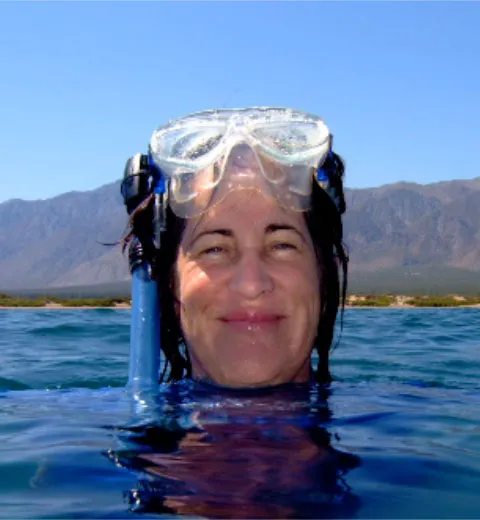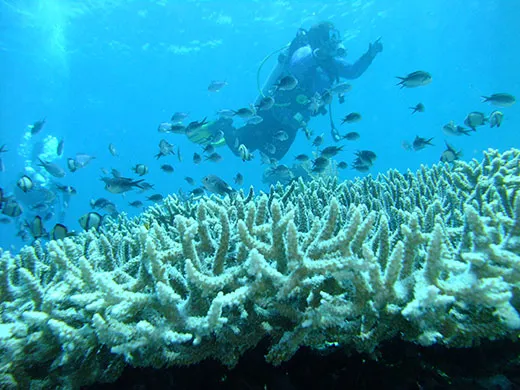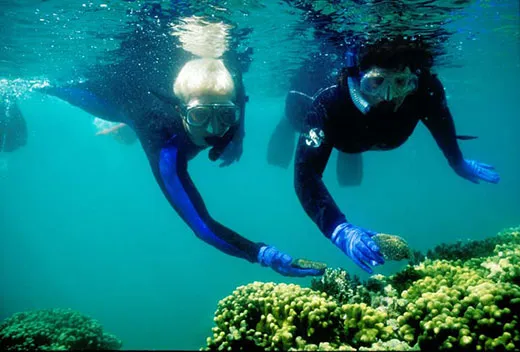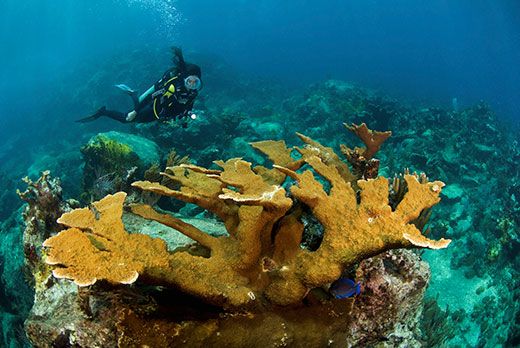Saving Coral…Through Sperm Banks?
Marine biologist Mary Hagedorn has learned to freeze and reanimate coral cells
/https://tf-cmsv2-smithsonianmag-media.s3.amazonaws.com/filer/coral-reef-extinction-631.jpg)
The outstretched giant squid at our backs and the tail of a 45-foot model right whale looming above our heads in the National Museum of Natural History’s Ocean Hall make it easy to imagine we are sitting on a coral reef. Mary Hagedorn, a marine biologist with the Smithsonian Conservation Biology Institute, sketches the scene: “Let’s say it is all one species. We can imagine Acropora palmata. They look like sequoias. They are mammoth corals, and there are hundreds of them in front of us.”
The endangered species, also known as elkhorn coral because its branches resemble elk antlers, is found in shallow water throughout the Caribbean. Once a year, in August or September, the species reproduces sexually in a method called “broadcast spawning.” Using the moon, sunset (which they sense through photoreceptors) and a chemical that allows them to “smell” each other, neighboring colonies synchronize their spawning. For two to four nights, each individual coral polyp on a colony releases a bundle of eggs and sperm into the water column. The sacs, which Hagedorn describes as looking like clusters of grapes, drift to the surface where they break, mix together with those from other colonies and fertilize one another.
Hagedorn has witnessed a total of 63 spawns from ten different species, including Acropora palmata, in the Caribbean and Pacific. “We’ll have some in front of us going and maybe some to the left and some to the right in those populations,” she says, waving her arms as if conducting an orchestra of spawning corals in our imaginary reef.
Coral reefs are home to one-quarter of all marine species. They protect shorelines from hurricanes and tsunamis and are a source of potential biopharmaceuticals. But in the past 30 years, a staggering 80 percent of corals have been destroyed in the Caribbean alone. Coral diseases are running rampant as water quality worsens, and the burning of fossil fuels has increased the amount of carbon dioxide dissolved in seawater, which in turn increases the water’s acidity. The skeletal deposits of corals, which form reefs, corrode in acidic water like teeth in soda. About one-third of all corals are in threat of extinction, and some coral experts say that we could lose reefs as we know them by 2050.
Until seven years ago, Hagedorn studied fish. But having had some success cryopreserving fish embryos—that is, freezing and storing them for later use—she thought she might be able to apply some of the same techniques to coral. In 2004, to be closer to spawning coral, she moved from Washington, D.C. to the northeast coast of Oahu, where she is stationed at the Hawaii Institute of Marine Biology at Coconut Island. She has created the first frozen repositories of coral sperm and embryonic cells. The “sperm banks,” with samples from elkhorn coral and Hawaiian mushroom coral, are an insurance policy of sorts, in that they could be tapped one, 50 or even 1,000 years from now to restore and add genetic diversity to dying populations. “My thing is that I plan for the worst and hope for the best,” she says. “It is such a small price to make a frozen bank. And, the cost of not doing it is so astronomical. It doesn’t make sense not to.”
The challenge for Hagedorn is being in the right place at the right time. In Oahu, she is in ready position when Hawaiian mushroom corals spawn two days after the full moon in June, July, August and September. Over time, she has tweaked her methods for collecting gametes. When the corals are beginning to “set,” meaning they are becoming pimpled with egg-sperm bundles ready to be released, Hagedorn and her team of divers put fine, custom-fit nets over individual corals. On the net is a plastic funnel, attached to a specimen cup, and a float. After the corals spawn, kayakers collect the samples and bring them to shore. “Really what we are hoping is that this is the type of process that we can teach almost any scientist, and they can do it on a little lab on the beach,” she says.
The sperm and eggs are only viable for a few hours, so Hagedorn and her team work quickly. In the lab, once the sacs fall apart, Hagedorn cleans the eggs and studies the motility and concentration of the sperm under a microscope, in much the same way that human fertility specialists do. She usually likes to gather sperm from five to seven males to freeze. If she is working with a new species, Hagedorn tests different freezing rates. The sperm is cooled from room temperature all the way down to liquid nitrogen temperature, or minus 324 degrees Fahrenheit, at maybe 10, 20 or 30 degrees per minute. She will then thaw the sperm, check its motility and decide on the rate that results in the greatest percentage of strong swimmers. In the critical test of the process, Hagedorn has successfully used frozen coral sperm to fertilize fresh eggs.
Hagedorn is also freezing coral embryonic cells. To do this, she fertilizes fresh eggs with fresh sperm and, depending on the species, waits about 12 to 24 hours for the embryos to grow. Then, she pulls those embryos apart and freezes the embryonic cells. “We don’t know how to do it now, but in the future, we will hopefully be able to take those embryonic cells that more than likely have coral stem cells in them and coax them into individual coral,” says Hagedorn. “My hope is that human stem cell biology will move at such a fast pace that we will be able to quickly draw on those advances and apply it to coral.”
Hagedorn is working on expanding her Hawaiian bank to include sperm and embryonic cells from rice coral, a species that is prone to disease and bleaching. For two weeks in August, she visited Smithsonian’s Carrie Bow Cay Marine Laboratory in Belize to bank endangered staghorn coral. “Now is the time to be collecting,” says Hagedorn, while there is still a lot of genetic diversity in the ocean’s coral. “Not 20 years from now when populations may have collapsed even further.” Come November, Hagedorn and the Smithsonian Conservation Biology Institute, in partnership with the Australian Institute of Marine Science, Sydney’s Taronga Zoo and others, will create a frozen sperm bank for two main coral species from the Great Barrier Reef.
Nancy Knowlton, a renowned coral reef biologist and the Smithsonian’s Sant chair of marine science at the Natural History Museum, agrees with Hagedorn that scientists should be using what tools they have to mitigate coral loss. Cryopreservation, she says, is a “very important tool in the tool box.”
“Corals normally spawn and reproduce, and they don’t need us to assist them,” says Knowlton. “But given the precarious state of reefs around the planet, it may well be that for some species, especially rare species, we are going to need to draw on these cryopreserved banks to make sure that they don’t go extinct.”
Hagedorn is working to develop other tools as well, honing a method of freezing small, one- to two-millimeter fragments of corals. In addition to reproducing sexually, coral can reproduce asexually—if a piece breaks off, it can take root in the sea floor and start a new colony. “Upon thawing, these small adults could be glued down and possibly become reproductive within years,” says Hagedorn. She is also an advocate for raising coral larvae in aquariums around the world. In Curacao, a group of scientists with SECORE, a coral consortium founded in 2002 that Hagedorn is a member of, is experimenting with rearing corals in a semi-natural environment, piping in water from a reef so that the young corals are exposed to the pathogens and temperature swings of the wild, without the predators.
Of course, cryopreservation and coral restoration must go hand in hand with working to improve the health of wild ecosystems. “It doesn’t do any good to put nice little juvenile corals that you have raised up from eggs and sperm out in the field if the conditions that killed the corals to begin with are still prevailing,” says Knowlton.
Hagedorn would ultimately like to see coral cell cryopreservation carried out on a global scale. “She’s taught me a lot about having passion for what you do, and having perseverance to stick it out and continue on with things you believe in,” says Ginnie Carter, a biotechnician in Hagedorn’s lab.
“If we lose our coral reefs, it will be the first ecosystem that we have lost while man is alive. It will be on our watch and most of it due to us. I don’t think that is acceptable,” says Hagedorn. She takes seriously the need for people to feel a personal responsibility to take care of the earth. “For me, my contribution is coral,” she says.
/https://tf-cmsv2-smithsonianmag-media.s3.amazonaws.com/accounts/headshot/megan.png)




/https://tf-cmsv2-smithsonianmag-media.s3.amazonaws.com/accounts/headshot/megan.png)